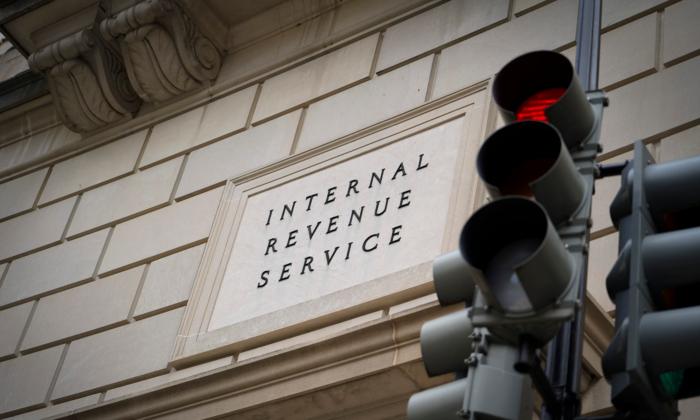The Internal Revenue Service (IRS) is looking to hire over 3,700 additional tax enforcers as it ramps up its audit crackdown of higher-earning taxpayers, though a watchdog warns that Americans making less than $400,000 could get caught in the dragnet because the agency doesn’t have a clear definition of “high-income.”
The IRS said on Sept. 15 that it had opened over 3,700 positions nationwide to assist with “expanded enforcement work” that focuses on complex partnerships, large corporations, and high-income earners.
The hiring will be for higher-graded revenue agents, with the IRS calling on people in the financial services industry—such as tax accountants, forensic accountants, auditors, and controllers—to apply.
The IRS is flush with cash from a recent congressionally-mandated infusion of $60 billion in new funding, with some of the money already having bolstered the tax agency’s ranks substantially. Recent reports indicate that hiring is up around 13 percent over the past year, allowing the IRS to hit a decade-high of nearly 90,000 staffers.
But while the recent batch of new hires was focused on taxpayer service positions, the newly announced hiring thrust is looking to give the IRS more enforcement muscle.
“This next wave of hiring will help the IRS add key talent like tax accountants to help reverse a decade-long decline of audits for the wealthy as well as complex partnerships and corporations,” IRS Commissioner Danny Werfel said in a statement.
“These new employees will be focused on higher-income and complex tax areas like partnerships, not average taxpayers making less than $400,000,” Mr. Werfel added.
No Clear Definition of ‘High-Income’
The Treasury Inspector General for Tax Administration (TIGTA), which is the watchdog overseeing the IRS, recently carried out a review to assess the IRS’s strategy to train employees hired to audit high earners and big businesses that underreport income.The watchdog report includes scathing criticism of the IRS for lacking a clear definition of “high-income” earners—despite the very same watchdog asking the IRS to look into developing a better definition years ago.
“The IRS does not have a unified or updated definition for individual high-income taxpayers,” the watchdog said in the report, which notes that the IRS uses different definitions of “high-income” depending on context as various IRS programs address different compliance issues across different parts of the filing population.
TIGTA faulted the IRS for still not having a clear definition of “high-income” for tax compliance even though the watchdog recommended in 2015 that the IRS reevaluate the appropriate income thresholds for its high-income and high-wealth strategy.
“The high-income terminology is being used loosely inside the IRS with no common understanding of what the term means,” the watchdog said.
The watchdog said that in response to its recommendation to the IRS nearly a decade ago to reevaluate its income thresholds, the IRS “made no changes,” citing “internal data analysis results and resource constraints.”
Also, the IRS continues to rely on old tax examination activity codes adopted half a century ago with the Tax Reform Act of 1976, which used a $200,000 threshold to measure high-income returns.
“This amount is equivalent to more than $1 million in 2023, but the IRS still uses $200,000 as the default high-income threshold,” the watchdog said, adding that the $200,000 threshold is “no longer a reasonable standard for high earners given inflation since 2005.”
More Details
One of the watchdog’s recommendations was for the IRS to establish a definition for high-income taxpayers for examination compliance purposes and that, “at a minimum, the IRS should accept the Treasury secretary’s $400,000 directive as the new high-income floor on which IRS leadership can focus enforcement efforts.”The IRS disagreed with the watchdog’s recommendation. It asserted in a statement included in the report that a “static and overly proscriptive” definition of high-income taxpayers for audit purposes “would serve to deprive the IRS of the agility to address emerging issues and trends.”
The watchdog commented on the IRS' pushback, saying that the definition need not be “static” and income thresholds should be adjusted based on economic and complexity factors—otherwise there’s a risk that the agency will break its pledge not to audit more Americans earnings less than $400,000.
“When the high-income thresholds are set too low, the result can be higher numbers of inefficient examinations,” the watchdog said. “When the definition is too low, the base of taxpayers earning those incomes is wider so that the IRS does many more audits in that category in order to achieve desired audit coverage.”
The watchdog said that, under the circumstances of a lack of a clear definition of “high-income,” the IRS would not only be conducting more audits on lower-earning Americans (contrary to its pledge not to), but it would also be less effective at its stated goal of closing the tax gap.
The watchdog also said that the IRS’s lack of action in response to the TIGTA recommendation in 2015 to reevaluate its income thresholds means that the IRS is in a difficult position if it hopes to meet its pledge not to raise audit rates above historical norms for Americans earning less than $400,000.
“Because $400,000 will be an important threshold, the IRS needs to update the examination activities codes for individual tax returns,” the watchdog recommended.
Currently, “there is no way to identify the complete population of taxpayers that meet the criterion of $400,000 or more specified by the current Treasury Secretary,” the watchdog added.
The IRS partially agreed with the watchdog’s recommendation to refine its examination activity.
“The IRS agreed to identify the best method to identify and track high-income examinations as part of the work being undertaken to implement the Treasury Secretary’s directive to not increase audit rates for households making less than $400,000 and small businesses,” the IRS said in a statement included in the report.
But the watchdog responded by saying this isn’t good enough.
“The IRS’s partial agreement and planned corrective action will not satisfy the intent of our recommendation, and additional actions are needed,” TIGTA said in a comment.
“The IRS should establish examination activity codes for additional TPI increments, which will help the IRS identify noncompliance at different income levels,” the watchdog added. TPI stands for “taxpayer profile increment.”
Asked for comment on the watchdog’s rejection of the IRS’s response to its recommendation, the IRS simply pointed to its original response included in the report.







